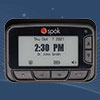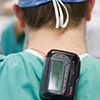Blog
Is modern paging an oxymoron? How pagers work in 2024
In recent years, smartphones and tablets have become integral to clinical communications. Yet even today, no mobile communication technology is more reliable, survivable, and affordable than the pager.
After more than 50 years of use pagers still matter, have a multitude of benefits, and are still crucial in healthcare. In fact, in our 2023 report: The state of healthcare communications, 81% of respondents indicate they use pagers at their organizations for secure communication, citing reliability over other forms of communication as the primary reason.
To truly understand the value of pagers for hospitals and healthcare systems, it’s important to understand a few things: how a pager works, what a paging network is, how modern paging differs from the paging you might remember, and how a hospital or clinical setting can best leverage the capabilities of modern paging.
How does a pager work?
A pager is a small telecommunication device that receives radio signals from the paging network. Transmitters in the paging networks broadcast signals over a specific frequency. Pagers that are physically in range of the transmitters listen to the signal from the transmitter. When your pager hears its unique address, it receives the message and alerts you (via an audible signal and/or a vibration, depending on pager settings).
Learn more about how pagers work in this infographic.
What is a paging network?
There are two types of paging networks:
- On-site systems use low and high-power transmitters to send local messages or for in-house notifications, similar to the kind used at a restaurant to let you know that your table is ready.
- Wide-area networks rely on high-powered transmitters across the country for nationwide coverage.
Paging networks are superior to cellular networks in a lot of ways. Notably, paging transmitters use high frequency radio signals with antennas that are typically located high off the ground so they can extend farther with fewer transmitters and less interference. That’s why pagers are so well-suited to a hospital setting where thick concrete walls and basement facilities often make cellular service unreliable. Paging networks also use multiple towers simultaneously, providing overlapping coverage.
How is modern paging different than its earlier days?
Modern paging networks use sophisticated satellite connections between the core messaging network and transmitter towers. This bypasses vulnerable telephone and RF link networks, providing a higher degree of efficacy and security.
Unlike the “old” days of paging, which required an infrastructure of dedicated wired phone lines and RF link transmitter systems, most modern paging is 100% digital using common IP protocols.
What do I need to know in order to make paging work best for my organization?
Not all paging systems are created alike. Chief concerns include efficacy/coverage and security. The most secure and reliable paging networks rely on a checkerboard pattern of transmitter sites. This is the approach that Spok employs for its industry-leading paging services.
Since hospitals and clinical settings are bound by HIPAA and other regulations, proper data encryption is essential. Today, some pagers (like the Spok Gen A™) support message encryption using the AES-128 encryption algorithm, which is the industry standard.
With encrypted pagers, each device is programmed with a unique encryption key. Messages are encrypted as they enter the network, sent over the satellite network to the transmitters and then sent over the air to the device, where they are decrypted for display to the user.
Whether you need to communicate a system-wide emergency message or let one person know that there is a front desk delivery for them, paging is a fast, efficient, cost-effective, and unobtrusive solution.
For more information, read our infographic about the ongoing power of paging.






